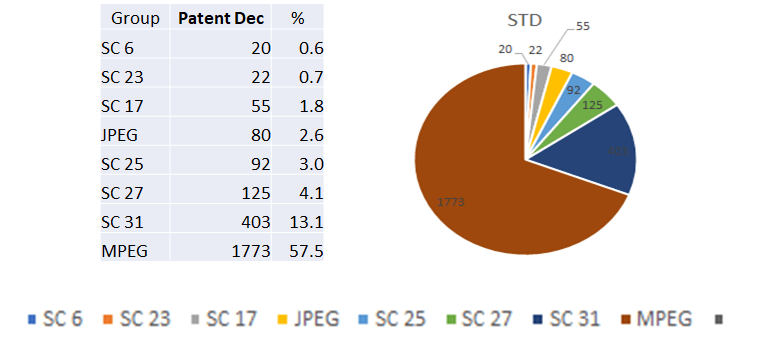MPEG is known for a variety of reasons. It is the group that carried over analogue television and made it digital, multiplying by orders of magnitude the number of channels, it opened the way to new business models for audio, it enabled carriage of digital media on the internet, added media to the mobile experience, is poised to make immersive media real and genomics affordable, and more.
MPEG achieved these goals – and keeps on setting, working on and achieving more goals – with technical specifications of minuscule material or immaterial things that have a big impact on devices and service delivering infrastructures that are worth billions of USD.
I never tire of saying that every year products that rely on MPEG standards to function or to be attractive to buying global customers are worth more than 1 trillion USD. Similarly for services, which are worth more than 500 billion USD p.a.
There is something emblematically immaterial that has driven the success of MPEG – Patents, the engine that has allowed the MPEG machine to pile up records.
When MPEG developed its first and second standards it could draw from decades of research in audio and video coding. MPEG-1 and MPEG-2 were extremely successful and patent holders were handsomely rewarded. This encouraged more researchers and companies to file more patents so that, when MPEG engaged in new generations of coding standards it could draw from a wider and fresher set of technologies.
The story is not without hiccups. Overall, however, it is a success story that puts MPEG on a different league than any other ISO committee. This is shown by the figure below

You see that patent declarations made to ISO by entities believing they hold patents relevant to MPEG standards are 57.5% of ALL patent declarations received by ISO. The next committee is JTC 1/SC 31 Automatic identification and data capture techniques which totals less than ¼ of MPEG patent declarations (and it is a Subcommittee). All other committees mentioned in the table are JTC 1 SCs. Other ISO TCs have typically a low or even zero number of patent declarations.
You can get the data yourself from the ISO website.
MPEG should stay as the defender of a “business model” that has offered a relentless expansion of the business to all facets of the media industry and to consumers the possibility to enjoy newer and fresher experiences.
Probably you can answer yourself why there is a battle around MPEG.
Posts in next thread
Posts in this thread
- Why is there a battle around MPEG?
- Strategic planning for MPEG
- Leonardo: who I am, what I have done so far, what I plan to do next
- The value of MPEG standards
- Design and build the future of MPEG
- Another view at MPEG’s strengths and weaknesses
- An “unexpected” MPEG media type: fonts
- The future of visual information coding standards
- Can MPEG survive? And if so, how?
- Quality, more quality and more more quality
- Developing MPEG standards in the viral pandemic age
- The impact of MPEG on the media industry
- MPEG standards, MPEG software and Open Source Software
- The MPEG Metamorphoses
- National interests, international standards and MPEG
- Media, linked media and applications
- Standards and quality
- How to make standards adopted by industry
- MPEG status report (Jan 2020)
- MPEG, 5 years from now
- Finding the driver of future MPEG standards
- The true history of MPEG’s first steps
- Put MPEG on trial
- An action plan for the MPEG Future community
- Which company would dare to do it?
- The birth of an MPEG standard idea
- More MPEG Strengths, Weaknesses, Opportunities and Threats
- The MPEG Future Manifesto
- What is MPEG doing these days?
- MPEG is a big thing. Can it be bigger?
- MPEG: vision, execution,, results and a conclusion
- Who “decides” in MPEG?
- What is the difference between an image and a video frame?
- MPEG and JPEG are grown up
- Standards and collaboration
- The talents, MPEG and the master
- Standards and business models
- On the convergence of Video and 3D Graphics
- Developing standards while preparing the future
- No one is perfect, but some are more accomplished than others
- Einige Gespenster gehen um in der Welt – die Gespenster der Zauberlehrlinge
- Does success breed success?
- Dot the i’s and cross the t’s
- The MPEG frontier
- Tranquil 7+ days of hard work
- Hamlet in Gothenburg: one or two ad hoc groups?
- The Mule, Foundation and MPEG
- Can we improve MPEG standards’ success rate?
- Which future for MPEG?
- Why MPEG is part of ISO/IEC
- The discontinuity of digital technologies
- The impact of MPEG standards
- Still more to say about MPEG standards
- The MPEG work plan (March 2019)
- MPEG and ISO
- Data compression in MPEG
- More video with more features
- Matching technology supply with demand
- What would MPEG be without Systems?
- MPEG: what it did, is doing, will do
- The MPEG drive to immersive visual experiences
- There is more to say about MPEG standards
- Moving intelligence around
- More standards – more successes – more failures
- Thirty years of audio coding and counting
- Is there a logic in MPEG standards?
- Forty years of video coding and counting
- The MPEG ecosystem
- Why is MPEG successful?
- MPEG can also be green
- The life of an MPEG standard
- Genome is digital, and can be compressed
- Compression standards and quality go hand in hand
- Digging deeper in the MPEG work
- MPEG communicates
- How does MPEG actually work?
- Life inside MPEG
- Data Compression Technologies – A FAQ
- It worked twice and will work again
- Compression standards for the data industries
- 30 years of MPEG, and counting?
- The MPEG machine is ready to start (again)
- IP counting or revenue counting?
- Business model based ISO/IEC standards
- Can MPEG overcome its Video “crisis”?
- A crisis, the causes and a solution
- Compression – the technology for the digital age



